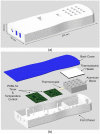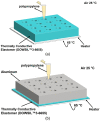A deep learning-driven low-power, accurate, and portable platform for rapid detection of COVID-19 using reverse-transcription loop-mediated isothermal amplification
- PMID: 35260715
- PMCID: PMC8903312
- DOI: 10.1038/s41598-022-07954-2
A deep learning-driven low-power, accurate, and portable platform for rapid detection of COVID-19 using reverse-transcription loop-mediated isothermal amplification
Abstract
This paper presents a deep learning-driven portable, accurate, low-cost, and easy-to-use device to perform Reverse-Transcription Loop-Mediated Isothermal Amplification (RT-LAMP) to facilitate rapid detection of COVID-19. The 3D-printed device-powered using only a 5 Volt AC-DC adapter-can perform 16 simultaneous RT-LAMP reactions and can be used multiple times. Moreover, the experimental protocol is devised to obviate the need for separate, expensive equipment for RNA extraction in addition to eliminating sample evaporation. The entire process from sample preparation to the qualitative assessment of the LAMP amplification takes only 45 min (10 min for pre-heating and 35 min for RT-LAMP reactions). The completion of the amplification reaction yields a fuchsia color for the negative samples and either a yellow or orange color for the positive samples, based on a pH indicator dye. The device is coupled with a novel deep learning system that automatically analyzes the amplification results and pays attention to the pH indicator dye to screen the COVID-19 subjects. The proposed device has been rigorously tested on 250 RT-LAMP clinical samples, where it achieved an overall specificity and sensitivity of 0.9666 and 0.9722, respectively with a recall of 0.9892 for Ct < 30. Also, the proposed system can be widely used as an accurate, sensitive, rapid, and portable tool to detect COVID-19 in settings where access to a lab is difficult, or the results are urgently required.
© 2022. The Author(s).
Conflict of interest statement
The authors declare no competing interests.
Figures











Similar articles
-
Multisite Clinical Validation of Isothermal Amplification-Based SARS-CoV-2 Detection Assays Using Different Sampling Strategies.Microbiol Spectr. 2021 Oct 31;9(2):e0084621. doi: 10.1128/Spectrum.00846-21. Epub 2021 Oct 20. Microbiol Spectr. 2021. PMID: 34668736 Free PMC article.
-
Clinical testing on SARS-CoV-2 swab samples using reverse-transcription loop-mediated isothermal amplification (RT-LAMP).BMC Infect Dis. 2022 Aug 18;22(1):697. doi: 10.1186/s12879-022-07684-w. BMC Infect Dis. 2022. PMID: 35982419 Free PMC article.
-
Development of a portable multi-step microfluidic device for point-of-care nucleic acid diagnostics.Anal Chim Acta. 2025 Jan 22;1336:343518. doi: 10.1016/j.aca.2024.343518. Epub 2024 Dec 5. Anal Chim Acta. 2025. PMID: 39788671
-
Loop-mediated isothermal amplification (LAMP): An effective molecular point-of-care technique for the rapid diagnosis of coronavirus SARS-CoV-2.Rev Med Virol. 2021 Nov;31(6):e2215. doi: 10.1002/rmv.2215. Epub 2021 Jan 21. Rev Med Virol. 2021. PMID: 33476080 Free PMC article. Review.
-
Colorimetric strategies applicable for loop-mediated isothermal amplification.J Microbiol Methods. 2024 Aug;223:106981. doi: 10.1016/j.mimet.2024.106981. Epub 2024 Jun 28. J Microbiol Methods. 2024. PMID: 38945305 Review.
Cited by
-
Adaptation of a Model Spike Aptamer for Isothermal Amplification-Based Sensing.Sensors (Basel). 2024 Oct 26;24(21):6875. doi: 10.3390/s24216875. Sensors (Basel). 2024. PMID: 39517771 Free PMC article.
-
Rapid SARS-CoV-2 Detection Using the Lucira™ Check It COVID-19 Test Kit.Diagnostics (Basel). 2022 Aug 3;12(8):1877. doi: 10.3390/diagnostics12081877. Diagnostics (Basel). 2022. PMID: 36010227 Free PMC article.
References
-
- World Health Organization. Available: https://www.who.int/ (2020).
-
- World Health Organization. WHO Coronavirus Disease (COVID-19) Dashboard. Available: https://covid19.who.int/ (2021).
-
- C. f. D. Control and Prevention, "Scientific Brief: Community Use of Cloth Masks to Control the Spread of SARS-CoV-2. Updated 10 November 2020," ed (2020).
Publication types
MeSH terms
Substances
Supplementary concepts
Grants and funding
- CPRA-2020-026/Khalifa University of Science, Technology and Research
- CPRA-2020-026/Khalifa University of Science, Technology and Research
- CPRA-2020-026/Khalifa University of Science, Technology and Research
- CPRA-2020-026/Khalifa University of Science, Technology and Research
- CPRA-2020-026/Khalifa University of Science, Technology and Research
LinkOut - more resources
Full Text Sources
Medical
Miscellaneous

